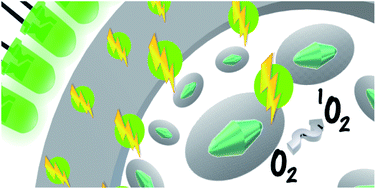Au nanobipyramids@mSiO2 core–shell nanoparticles for plasmon-enhanced singlet oxygen photooxygenations in segmented flow microreactors†‡
Abstract
The plasmonic features of gold nanomaterials provide intriguing optical effects which can find potential applications in various fields. These effects depend strongly on the size and shape of the metal nanostructures. For instance, Au bipyramids (AuBPs) exhibit intense and well-defined plasmon resonance, easily tunable by controlling their aspect ratio, which can act synergistically with chromophores for enhancing their photophysical properties. In Rose Bengal-nanoparticle systems it is now well established that the control of the dye-to-nanoparticle distance ranging from 10 to 20 nm as well as spectral overlaps is crucial to achieve appropriate coupling between the plasmon resonance and the dye, thus affecting its ability to generate singlet oxygen (1O2). We have developed AuBPs@mSiO2 core–shell nanostructures that provide control over the distance between the metal surface and the photosensitizers for improving the production of 1O2 (metal-enhanced 1O2 production – ME1O2). A drastic enhancement of 1O2 generation is evidenced for the resulting AuBPs and AuBPs@mSiO2 in the presence of Rose Bengal, using a combination of three indirect methods of 1O2 detection, namely in operando Electron Paramagnetic Resonance (EPR) with 2,2,6,6-tetramethylpiperidine (TEMP) as a chemical trap, photooxygenation of the fluorescence probe anthracene-9,10-dipropionic acid (ADPA), and photooxygenation of methionine to methionine sulfoxide in a segmented flow microreactor.



 Please wait while we load your content...
Please wait while we load your content...